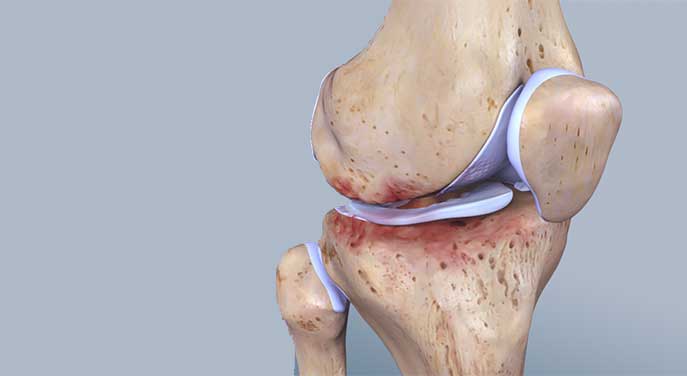Female astronauts could avoid knee injuries during space flight – and better tests, prevention and treatments could be developed for knee osteoarthritis in women on Earth – based on newly published research on the sex differences in knee meniscus tissue.

Adetola Adesida
Knee osteoarthritis is more common in females than in males, but hormones alone are not enough to explain the difference. The new research identifies a genetic difference in the meniscus that makes about 50 per cent of females more vulnerable to developing osteoarthritis than males or other females.
Researchers carried out the experiments in part by simulating low-gravity conditions in space, which mimics the damage that can happen to the meniscus due to lack of exercise.
“Some of the genes that were found in the females that responded more to simulated space microgravity were also associated with the development of knee osteoarthritis,” said principal investigator Adetola Adesida, professor of surgery in the Faculty of Medicine and Dentistry.
The research suggests the potential for a blood test to identify who has the high-risk gene, allowing for early interventions such as physiotherapy and eventually even drug therapy. It might also allow women to stay in space longer.
“We’ve uncovered the mechanisms that lead to this higher response, and we are hoping to develop drugs to target those pathways and block those responses,” Adesida said.
The meniscus is a kind of cartilage in the knee that acts as a load distributor for the body’s full weight. At one time, it was thought to be like the appendix: you wouldn’t miss it if it were gone. But now, it’s known that just a small tear in the meniscus – usually caused by a sports injury – increases the risk of osteoarthritis later in life, even if the damaged tissue has been removed.
On the other hand, lack of use can also lead to deconditioning of the meniscus and increase arthritis risk. You’ll notice the short-term effect of deconditioning when you get out of bed in the morning and feel stiff, but then your joints loosen up once you’ve moved around for a while. The same thing happens to astronauts in space unless they use specially designed resistance equipment to make up for the lack of weight-bearing exercise in microgravity.
Knee osteoarthritis is the most common joint problem, affecting an estimated 250 million people worldwide, including 14 per cent of females older than 60 and 10 per cent of males in the same age group. About 75,000 knee replacements were performed in Canada in 2019-20.
Adesida’s team has developed bioengineered meniscus tissue grown from cells that have been removed from the damaged menisci of otherwise healthy individuals. The hope is one day to replace damaged tissue through transplant, preventing the development of knee osteoarthritis.
“The goal is really to be able to use a patient’s own cells to make a new meniscus for them,” Adesida explained.
For their experiment on sex differences, the team studied how the bioengineered tissue functioned while at rest and under mechanical loading and unloading conditions. For the loading, they used a device that exerted hydrostatic pressure on the cells. For the unloading, they put the cells into a bioreactor designed by NASA to mimic minimal-gravity conditions.
They needed to do all this because it would not be ethical just to cut someone open to see what happens to their meniscus during exercise, an extended hospital stay or a space flight, Adesida pointed out.
“Our loading and unloading experiment mimics what we actually see in a clinical situation where the development of spaceflight microgravity-induced knee osteoarthritic changes is possible,” he said.
“This will help us to have human-relevant models to study knee osteoarthritis in the future. And our research has both Earth benefits and space benefits.”
Adesida runs the Adesida Laboratory of Cartilage Bioengineering and is director of the Orthopaedic Basic Science Research program within the department of surgery, associate director of the Otolaryngology Basic Science Research program and co-director of the ELITE Program for Black Youth at the U of A.
The research was a cross-disciplinary project co-led by Lindsey Westover, assistant professor in the Faculty of Engineering, and was funded by Natural Sciences and Engineering Research Council of Canada, Canadian Institutes of Health Research, Canada Foundation for Innovation, University Hospital of Alberta Foundation, Cliff Lede Family Charitable Foundation, University of Alberta Pilot Seed Grant Program, and Alberta Women’s Health Foundation through the Women and Children’s Health Research Institute.
| By Gillian Rutherford
Gillian is a reporter with the University of Alberta’s Folio online magazine. The University of Alberta is a Troy Media Editorial Content Provider Partner.
The opinions expressed by our columnists and contributors are theirs alone and do not inherently or expressly reflect the views of our publication.
© Troy Media
Troy Media is an editorial content provider to media outlets and its own hosted community news outlets across Canada.

